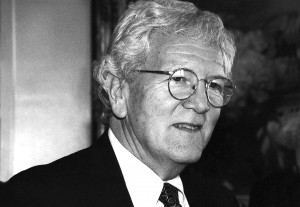This post is part of The Plank Center’s Legacies from Legends in PR Series that was begun in recognition of the 40th Anniversary of the Public Relations Student Society of America in 2007.
Served as corporate VP of Public Affairs and Corporate Communications at Johnson & Johnson until retiring. Previously worked with Carl Byoir & Associates and Hill and Knowlton. Served two terms as president of the Arthur W. Page Society and was inducted into its Hall of Fame in 2003. Past chairman of the Public Relations Seminar and the Institute for Public Relations. Served on the Board of the Global Public Relations Society of America; board member, the Josephson Institute of Ethics. Awarded The Plank Center’s Milestones in Mentoring Legacy Award (2017).
In the 40 years since the establishment of PRSSA, the practice of public relations has certainly come of age, especially in terms of the acceptance of this critical skill set by well-managed companies and institutions. This is good news for anyone considering this challenging and rewarding career field.
Our profession has developed to the point where another significant advance should be considered through the identification and articulation of a set of shared values and responsibilities – a universal statement of beliefs (beyond a code of ethics)–that would help to define the true character of public relations for both those who seek our services, and for those who choose this professional career path.
What might be some shared values and responsibilities that our profession should own?
The first should probably be about the “publics” or audiences–both internal and external–with whom we communicate, and the importance we place on telling the truth. We need to say that we value audiences that are well informed about our organizations or clients, and not just partly informed. Transparency would be a good value to own.
A second core value would be about how we see our responsibilities to clients. We’re accused of using “spin,” of always putting our clients first and the best face on events. In reality, what we strive to be are honest advocates for the positions taken by our companies or clients and the objectives they seek to pursue. “Honest advocacy,” I believe, requires that we maintain the highest personal integrity and a position of independence and objectivity within our own organizations–the level of independence that allows us to counsel freely on the formation of organizational policy and then insist on organizational behavior that is consistent with the public positions we have taken. It’s time to say this is what we value, and that we’re taking on this responsibility.
A third value would be around freedom of expression and the news media–traditional media and new media. After all, in the classic definition of public relations, we regard the media as gatekeepers–the third party–through which we seek to achieve credibility for the messages we direct at our audiences. Certainly we value and respect high journalistic standards such as fairness and balance. We should say so. But maybe we also need to say that we believe in freedom of expression and especially freedom of the press as the foundation of society.
A fourth core value relates to our own profession. We have a responsibility to advance understanding of the legitimacy of our function, what we value, the principles that guide our practice and the ethical standards we embrace. As well, we need to exhibit a personal commitment to the highest standards of individuals character and integrity–standards that we expect from each other and anyone who seeks to take up this practice.
I believe the public relations profession has reached the stage in its development where it has the opportunity to set itself apart, to clarify its values, roles and responsibilities and to achieve a singular character that is both palpable and enduring.
Published: 2007
More from Bill Nielsen:
